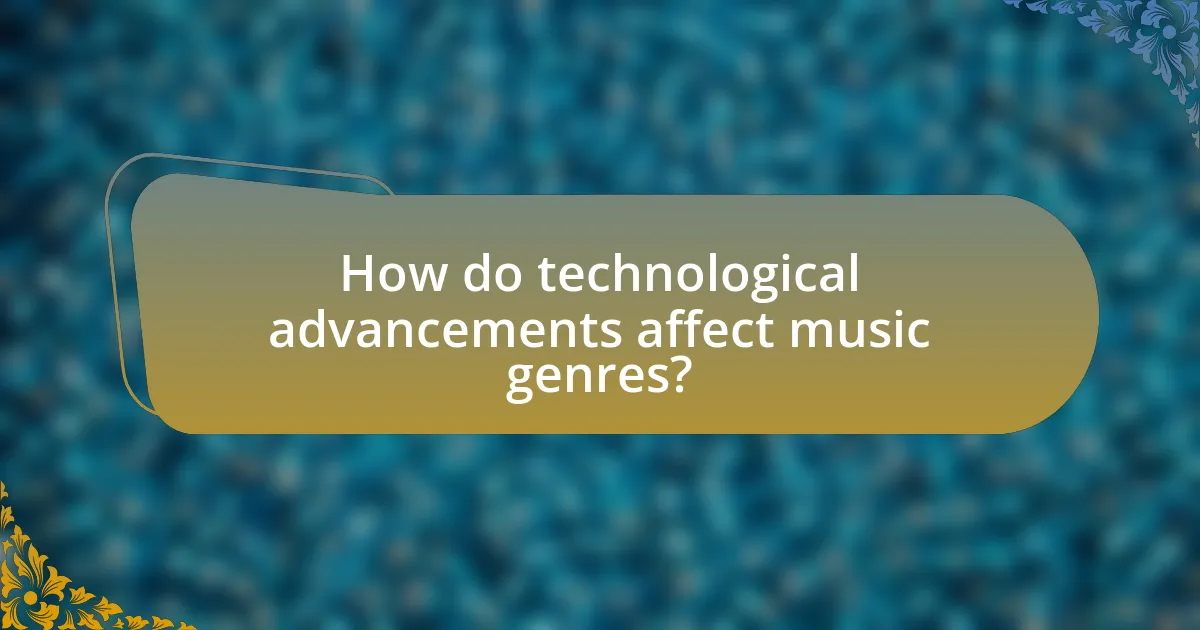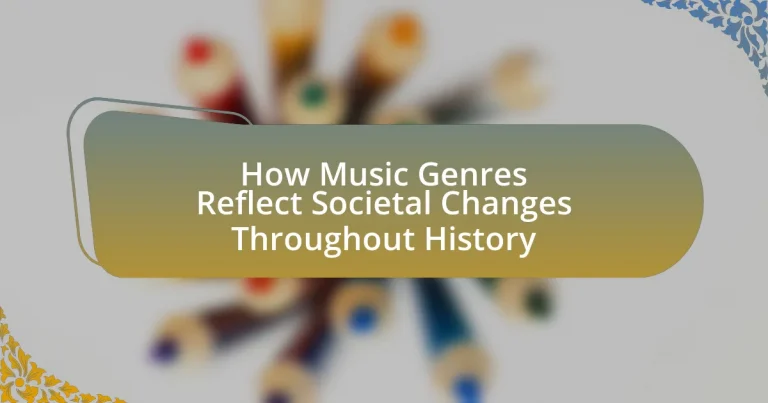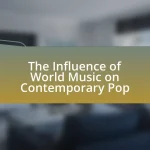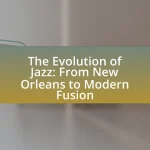The article examines how music genres serve as reflections of societal changes throughout history, highlighting the interplay between cultural, political, and social dynamics. It explores key historical periods that influenced music, such as the Renaissance and the Industrial Revolution, and discusses how genres like jazz, rock, and hip-hop articulate the experiences of marginalized communities and address societal issues. Additionally, the article analyzes the impact of technological advancements and social media on music production and consumption, as well as the role of youth cultures and demographic shifts in shaping musical styles. Ultimately, it emphasizes the potential of music genres to promote social change and reflect evolving cultural norms.

How do music genres reflect societal changes throughout history?
Music genres reflect societal changes throughout history by serving as a mirror to cultural, political, and social dynamics. For instance, the emergence of jazz in the early 20th century symbolized the African American struggle for civil rights and cultural identity, while rock and roll in the 1950s represented youth rebellion and the counterculture movement. Additionally, hip-hop, which gained prominence in the 1980s, articulated the experiences of marginalized communities and addressed issues such as poverty and systemic racism. These genres not only provide entertainment but also encapsulate the sentiments and challenges of their respective eras, demonstrating how music evolves in response to societal shifts.
What are the key historical periods that influenced music genres?
The key historical periods that influenced music genres include the Medieval period, the Renaissance, the Baroque era, the Classical period, the Romantic era, the 20th century, and the Digital age. Each of these periods contributed distinct characteristics and innovations to music. For instance, the Medieval period (500-1400) established the foundations of Western music with the development of notation and Gregorian chant. The Renaissance (1400-1600) introduced polyphony and greater emotional expression, influencing genres like choral music. The Baroque era (1600-1750) saw the emergence of opera and instrumental music, while the Classical period (1750-1820) emphasized clarity and form, leading to symphonic and chamber music. The Romantic era (1820-1900) focused on individual expression and nationalism, shaping genres such as art song and symphonic poems. The 20th century brought about jazz, blues, rock, and electronic music, reflecting societal changes and technological advancements. Finally, the Digital age (2000-present) has transformed music production and distribution, leading to genres like electronic dance music and the rise of streaming platforms. Each period’s innovations and cultural contexts significantly shaped the evolution of music genres.
How did the Renaissance shape musical styles and societal values?
The Renaissance significantly shaped musical styles and societal values by fostering a shift towards humanism and individual expression in music. This period saw the emergence of polyphony, where multiple independent melodies were sung simultaneously, reflecting the era’s emphasis on complexity and beauty in art. Composers like Josquin des Prez and Palestrina exemplified this shift, creating intricate vocal works that prioritized clarity and emotional expression.
Additionally, the invention of the printing press allowed for the widespread distribution of music, making it more accessible and promoting the idea of music as a communal experience. This democratization of music contributed to changing societal values, as music became a means of personal and collective identity, aligning with the Renaissance ideals of individualism and human experience. The blending of sacred and secular themes in compositions further illustrated the evolving cultural landscape, highlighting the importance of both religious and worldly perspectives in society.
What role did the Industrial Revolution play in the evolution of music genres?
The Industrial Revolution significantly influenced the evolution of music genres by facilitating the rise of new musical forms and the accessibility of music. This period, marked by technological advancements and urbanization, led to the development of genres such as jazz, blues, and folk music, which reflected the experiences of the working class and the cultural melting pot of urban environments. The invention of instruments like the saxophone and the widespread availability of sheet music allowed for greater experimentation and fusion of styles, contributing to the diversification of music genres. Additionally, the growth of the music industry, driven by mass production and distribution methods, enabled artists to reach broader audiences, further shaping the landscape of music during and after the Industrial Revolution.
How do music genres serve as a mirror to societal issues?
Music genres serve as a mirror to societal issues by reflecting the cultural, political, and economic contexts in which they emerge. For instance, genres like punk rock arose in response to social unrest and disillusionment with authority during the 1970s, particularly in the UK, where economic hardship and political turmoil were prevalent. Similarly, hip-hop has often addressed issues such as racial inequality and police brutality, with artists like N.W.A. explicitly critiquing systemic oppression in their lyrics. These genres not only provide a platform for marginalized voices but also document historical events and societal sentiments, making them vital for understanding the dynamics of their respective eras.
In what ways does protest music highlight social movements?
Protest music highlights social movements by serving as a powerful tool for expression, mobilization, and awareness. It articulates the grievances and aspirations of marginalized groups, often encapsulating their struggles in memorable lyrics and melodies. For instance, songs like “We Shall Overcome” became anthems during the Civil Rights Movement, uniting individuals and fostering a sense of solidarity. Additionally, protest music can influence public opinion and political discourse, as seen with Bob Dylan’s “The Times They Are a-Changin’,” which resonated with the anti-war sentiment of the 1960s. By providing a voice to the voiceless and galvanizing collective action, protest music plays a crucial role in shaping and reflecting the dynamics of social movements.
How does the evolution of popular music reflect changing cultural norms?
The evolution of popular music reflects changing cultural norms by mirroring societal values, beliefs, and issues prevalent during different historical periods. For instance, the rise of rock and roll in the 1950s symbolized a rebellion against conservative norms, promoting youth culture and sexual liberation. Similarly, the emergence of hip-hop in the 1970s and 1980s highlighted themes of racial identity, social justice, and economic struggle, reflecting the civil rights movement and urban experiences. Furthermore, the incorporation of LGBTQ+ themes in pop music during the late 20th and early 21st centuries illustrates a growing acceptance and visibility of diverse sexual orientations, aligning with broader societal shifts towards inclusivity. These examples demonstrate how popular music serves as a cultural barometer, capturing and influencing the zeitgeist of its time.
What are the connections between music genres and demographic shifts?
Music genres are closely connected to demographic shifts, as they often reflect the cultural, social, and economic changes within specific populations. For instance, the rise of hip-hop in the late 20th century coincided with urbanization and the increasing visibility of African American culture, particularly in cities like New York and Los Angeles. This genre emerged from the experiences of marginalized communities, addressing issues such as poverty, racism, and social injustice, which resonated with a growing demographic of young urban dwellers.
Additionally, the popularity of country music has been linked to demographic shifts in rural America, where the genre reflects the values and lifestyles of its predominantly white, working-class audience. As populations in these areas have changed due to migration and economic factors, the themes in country music have evolved, incorporating influences from other genres and reflecting the experiences of a more diverse audience.
Moreover, the globalization of music has led to the blending of genres, such as reggaeton, which combines Latin rhythms with hip-hop and dancehall influences, reflecting the demographic shifts in Latinx populations in the United States and beyond. This genre’s rise in popularity illustrates how music adapts to and represents the changing demographics of its listeners.
In summary, music genres serve as a mirror to demographic shifts, capturing the essence of societal changes and the evolving identities of different communities.
How do immigration and migration influence the development of new music genres?
Immigration and migration significantly influence the development of new music genres by facilitating the exchange of cultural sounds, rhythms, and instruments among diverse populations. For instance, the migration of African Americans to urban centers in the early 20th century led to the creation of jazz, which blended African musical traditions with European harmonies. Similarly, the influx of Latin American immigrants into the United States contributed to the rise of genres like salsa and reggaeton, which incorporate elements from various Latin styles and American music. Historical evidence shows that the Harlem Renaissance in the 1920s was a pivotal moment where cultural exchange through migration fostered the evolution of jazz and blues, highlighting how these movements shape musical landscapes.
What impact do youth cultures have on the emergence of music genres?
Youth cultures significantly influence the emergence of music genres by shaping musical styles, themes, and trends that resonate with their values and experiences. For instance, the rise of rock and roll in the 1950s was driven by the rebellious spirit of teenagers seeking to express their identity, leading to a genre that emphasized youth empowerment and social change. Similarly, the punk movement in the 1970s emerged as a reaction to societal norms, characterized by its raw sound and anti-establishment lyrics, reflecting the frustrations of youth at that time. These examples illustrate how youth cultures not only inspire new musical forms but also serve as catalysts for broader cultural shifts, demonstrating the profound connection between generational identity and musical innovation.

How do technological advancements affect music genres?
Technological advancements significantly influence music genres by enabling new sounds, production techniques, and distribution methods. For instance, the introduction of synthesizers in the 1960s and 1970s led to the emergence of electronic music genres such as techno and house, which transformed the musical landscape. Additionally, the advent of digital audio workstations (DAWs) in the 1990s democratized music production, allowing independent artists to create and distribute music without traditional studio constraints, thus fostering genres like indie pop and lo-fi. Furthermore, streaming platforms have reshaped how music is consumed, leading to the rise of genre-blending and the popularity of niche genres, as artists can reach global audiences more easily. These advancements illustrate how technology not only alters the sound of music but also the way it is created and shared, reflecting broader societal changes in accessibility and creativity.
What role does technology play in the production and distribution of music?
Technology plays a crucial role in the production and distribution of music by enabling artists to create, record, and share their work more efficiently and widely. Digital audio workstations (DAWs) allow musicians to produce high-quality recordings from home studios, significantly reducing the cost and time associated with traditional studio recording. For instance, the rise of software like Pro Tools and Ableton Live has democratized music production, allowing independent artists to compete with major labels.
Moreover, streaming platforms such as Spotify and Apple Music have transformed music distribution, providing artists with global reach and real-time analytics on listener engagement. According to the Recording Industry Association of America (RIAA), streaming accounted for 83% of the U.S. music industry’s revenue in 2020, highlighting the shift from physical sales to digital consumption. This technological evolution not only enhances accessibility for listeners but also influences music genres, as artists adapt their styles to fit the preferences of streaming audiences.
How has the internet transformed music consumption and genre popularity?
The internet has fundamentally transformed music consumption and genre popularity by enabling instant access to a vast array of music and facilitating the rise of diverse genres. Streaming platforms like Spotify and Apple Music have replaced traditional purchasing methods, allowing users to listen to millions of songs on demand, which has led to a significant increase in the consumption of niche genres that may have previously struggled for mainstream attention. For instance, according to a 2021 report by the International Federation of the Phonographic Industry, global music streaming revenues grew by 19.9%, highlighting the shift in how audiences engage with music. This accessibility has democratized music distribution, allowing independent artists to reach global audiences without the need for major label backing, thus reshaping genre popularity and encouraging the emergence of new styles.
What are the effects of digital recording technology on music genres?
Digital recording technology has significantly transformed music genres by enhancing production quality, democratizing access to music creation, and enabling new styles and sounds. The introduction of digital audio workstations (DAWs) has allowed artists to produce high-quality recordings from home studios, leading to a surge in independent music production. This shift has diversified genres, as seen in the rise of electronic music, hip-hop, and indie rock, which often blend traditional elements with innovative digital techniques. Furthermore, the ability to manipulate sound digitally has led to the emergence of sub-genres like lo-fi and vaporwave, which reflect contemporary cultural aesthetics. The widespread availability of digital tools has also facilitated cross-genre collaborations, fostering a more interconnected musical landscape.
How do social media platforms influence music genre trends?
Social media platforms significantly influence music genre trends by facilitating the rapid dissemination of music and enabling direct artist-to-fan interactions. These platforms, such as TikTok and Instagram, allow users to share snippets of songs, which can lead to viral trends and increased popularity for specific genres. For instance, TikTok’s algorithm promotes short, catchy clips, often resulting in the resurgence of genres like pop-punk and hip-hop, as seen with the viral success of songs like “Roxanne” by Arizona Zervas. Additionally, social media analytics provide artists and labels with real-time feedback on listener preferences, allowing them to adapt their music styles accordingly. This dynamic interaction between artists and audiences on social media shapes the evolution of music genres, reflecting broader societal changes and preferences.
In what ways do viral trends shape the popularity of specific music genres?
Viral trends significantly influence the popularity of specific music genres by rapidly disseminating songs and styles through social media platforms, leading to increased exposure and listener engagement. For instance, the rise of TikTok has propelled genres like rap and pop into mainstream success, as songs that go viral on the platform often see a surge in streaming numbers and chart performance. A notable example is Lil Nas X’s “Old Town Road,” which gained immense popularity after going viral on TikTok, resulting in it topping the Billboard Hot 100 for a record-breaking 19 weeks. This phenomenon illustrates how viral trends can create a feedback loop where increased visibility leads to greater popularity, ultimately shaping the music landscape.
How do online communities contribute to the evolution of music genres?
Online communities significantly contribute to the evolution of music genres by facilitating collaboration, sharing, and exposure among diverse artists and listeners. These platforms enable musicians to experiment with different styles and influences, leading to the fusion of genres, as seen in the rise of genres like lo-fi hip hop and electronic dance music. For instance, platforms like SoundCloud and Bandcamp allow independent artists to share their work globally, resulting in the rapid dissemination of new sounds and trends. Additionally, social media platforms foster discussions and fan engagement, which can influence the direction of music genres based on audience feedback and cultural shifts. This dynamic interaction within online communities accelerates the transformation and diversification of music genres, reflecting broader societal changes.

What are the future implications of music genres on society?
The future implications of music genres on society include the potential for increased cultural exchange and social cohesion. As music genres continue to evolve and blend, they foster cross-cultural collaborations that can enhance understanding and acceptance among diverse communities. For instance, the rise of genres like reggaeton and K-pop demonstrates how global influences can reshape local music scenes, leading to a more interconnected world. Additionally, studies indicate that music can influence social movements; for example, hip-hop has historically played a significant role in advocating for social justice, suggesting that future genres may similarly impact societal issues. This trend highlights the importance of music as a vehicle for change and expression in society.
How might emerging genres reflect future societal changes?
Emerging genres may reflect future societal changes by serving as a mirror to evolving cultural values, technological advancements, and social movements. For instance, the rise of genres like trap music illustrates the influence of urban culture and the impact of social issues such as inequality and systemic racism, which resonate with younger generations. Additionally, the integration of technology in music production, seen in genres like electronic dance music, showcases how digital innovation shapes artistic expression and accessibility. Historical trends indicate that music genres often emerge in response to societal shifts; for example, punk rock arose during economic downturns and political unrest in the 1970s, highlighting discontent and a desire for change. Thus, the evolution of music genres can be a direct reflection of the societal landscape, capturing the zeitgeist of the times.
What trends are currently shaping the future of music genres?
Current trends shaping the future of music genres include the rise of genre-blending, increased use of technology in music production, and the growing influence of social media on music distribution. Genre-blending, where artists combine elements from multiple genres, reflects a more diverse musical landscape and caters to varied listener preferences. The integration of technology, such as artificial intelligence and advanced software, allows for innovative sound creation and production techniques, enhancing the overall quality and accessibility of music. Additionally, social media platforms like TikTok and Instagram play a crucial role in promoting new artists and songs, enabling viral trends that can redefine genre popularity. These trends indicate a shift towards a more collaborative, experimental, and digitally-driven music industry.
How can music genres promote social change in the future?
Music genres can promote social change in the future by serving as platforms for activism and raising awareness about social issues. For instance, genres like hip-hop and punk have historically addressed themes of inequality, injustice, and resistance, influencing public opinion and mobilizing communities. The rise of digital platforms allows for broader dissemination of music, enabling artists to reach global audiences and inspire collective action. Research indicates that music can evoke emotional responses that motivate listeners to engage in social movements, as seen in the impact of protest songs during the Civil Rights Movement. Thus, the evolution of music genres will likely continue to reflect and drive societal changes by amplifying marginalized voices and fostering solidarity.
What practical steps can artists take to engage with societal issues through music?
Artists can engage with societal issues through music by creating songs that address specific social themes, collaborating with activists, and participating in community events. By writing lyrics that reflect current events or social injustices, artists can raise awareness and provoke thought among listeners. Collaborating with activists allows musicians to amplify their messages and reach broader audiences, as seen in the partnership between artists and organizations during movements like Black Lives Matter. Additionally, participating in community events, such as benefit concerts or workshops, enables artists to connect directly with their audience and foster dialogue around pressing societal issues. These steps have historically proven effective, as music has often served as a catalyst for social change, exemplified by genres like protest music in the 1960s.


